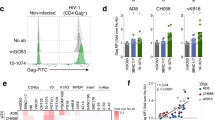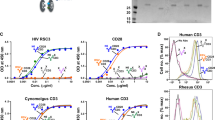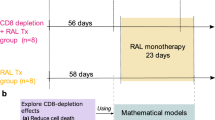Abstract
Human immunodeficiency virus (HIV) infection can bring about total collapse of the immune system1,2 by infecting helper T lymphocytes which express CD4, the molecule which mediates interaction between the cell surface and viral envelope glycoprotein gp!20 (refs 3–10). HIV apparently escapes the effects of neutralizing antibodies in vivo by generating new variants which must still interact with CD4 to maintain a cycle of infection11–14. One route to block HIV infection, therefore, could use solubilized CD4 protein to inhibit attachment of the virus to its target cell. We have used recombinant DNA techniques to generate soluble forms of CD4, and show here that these are potent inhibitors of HIV infection in vitro
This is a preview of subscription content, access via your institution
Access options
Subscribe to this journal
Receive 51 print issues and online access
$199.00 per year
only $3.90 per issue
Buy this article
- Purchase on Springer Link
- Instant access to full article PDF
Prices may be subject to local taxes which are calculated during checkout
Similar content being viewed by others
References
Curran, J. et al. Science 229, 1352–1357 (1985).
Weiss, R. et al. Nature 324, 572–575 (1986).
Dalgleish, A. et al. Nature 312, 763–766 (1984).
Klatzmann, D. & Gluckman, J. C. Immunol. Today 7, 291–297 (1986).
McDougal, J. et al. J. Immun. 135, 3151–3162 (1985).
Reinherz, E. L. & Schlossman, S. F. Cell 19, 821–827 (1980).
Klatzmann, D. et al. Nature 312, 767–768 (1984).
McDougal, J. et al. J. Immun. 137, 2937–2944 (1986).
Maddon, P. J. et al. Cell 47, 333–348 (1986).
Lasky, L. A. et al. Cell 50, 975–985 (1987).
Starcich, B. R. et al. Cell 45, 637–648 (1986).
Alizon, M., Wain-Hobson, S., Montagnier, L. & Sonigo, P. Cell 46, 63–74 (1986).
Willey, R. et al. Proc. Natn. Acad. Sci. U.S.A. 83, 5038–5042 (1986).
Hahn, B. et al. Science 232, 1548–1553 (1986).
Maddon, P. J. et al. Cell 42, 93–104 (1985).
Littman, D. R. & Gettner, S. N. Nature 325, 453–455 (1987).
Traunecker, A., Dolder, B. & Karjalainen, K. Eur. J. Immun. 16, 851–854 (1986).
Classon, J. B., Tsagarotos, J., McKenzie, I. F. & Walker, I. D. Proc. natn. Acad. Sci. U.S.A. 83, 4499–4503 (1986).
Harada, S., Purtilo, D. T., Koyanagi, Y., Sonnabend, J. & Yamamoto, N. J. immun. Meth. 92, 177–181 (1986).
Harada, S., Yoshiyama, H. & Yamamoto, N. J. Clin. Microbiol. 22, 908–911 (1985).
Harada, S., Koyonagi, Y. & Yamamoto, N. Science 229, 563–566 (1985).
Author information
Authors and Affiliations
Rights and permissions
About this article
Cite this article
Traunecker, A., Lüke, W. & Karjalainen, K. Soluble CD4 molecules neutralize human immunodeficiency virus type 1. Nature 331, 84–86 (1988). https://doi.org/10.1038/331084a0
Received:
Accepted:
Issue Date:
DOI: https://doi.org/10.1038/331084a0
This article is cited by
-
A novel gene therapy strategy using secreted multifunctional anti-HIV proteins to confer protection to gene-modified and unmodified target cells
Gene Therapy (2014)
-
HIV infection and oligosaccharides: A novel approach to preventing HIV infection and the onset of AIDS
Journal of Infection and Chemotherapy (1999)
-
Specific inhibition of CD4+ T lymphocytes by a hybrid antibody
Nature Biotechnology (1998)
-
FP-21399 blocks HIV envelope protein-mediated membrane fusion and concentrates in lymph nodes
Nature Biotechnology (1997)
-
Synthetic CD4 exocyclic peptides antagonize CD4 holoreceptor binding and T cell activation
Nature Biotechnology (1996)
Comments
By submitting a comment you agree to abide by our Terms and Community Guidelines. If you find something abusive or that does not comply with our terms or guidelines please flag it as inappropriate.



